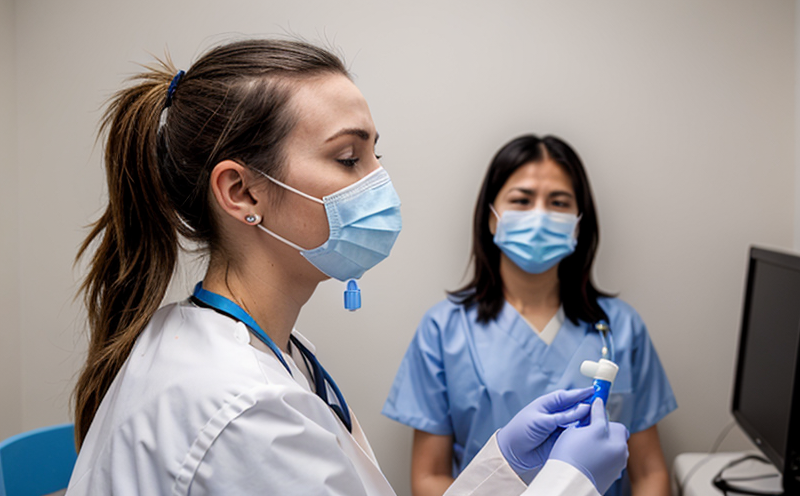Bioaerosol Sampling for Respiratory Disease Agents
Respiratory diseases are a significant public health concern worldwide. Bioaerosols—microscopic particles containing biological agents like bacteria, fungi, and viruses—are known carriers of these pathogens. Accurate bioaerosol sampling is crucial in identifying the presence of respiratory disease agents, facilitating early detection, containment, and treatment.
The process involves collecting airborne particles using specialized equipment designed to capture microorganisms. This method allows for detailed analysis under controlled laboratory conditions, providing insights into potential health risks within an environment. By understanding bioaerosol behavior, facilities can implement effective control measures to protect occupants from respiratory infections.
Our service focuses on the collection and analysis of bioaerosols specifically targeting respiratory disease agents such as influenza viruses, pneumococcus bacteria, and other airborne pathogens. This approach helps organizations meet regulatory requirements while enhancing occupational safety standards.
The sampling protocol adheres to international guidelines outlined by ISO, EN, ASTM, and IEC standards, ensuring consistency and reliability across various testing environments. Our team uses advanced technologies like real-time PCR (polymerase chain reaction) for rapid detection of targeted pathogens. This technology provides precise quantification and identification within minutes.
Once collected, samples undergo rigorous processing steps including preservation at optimal temperatures to maintain viability until analysis. Following extraction procedures, nucleic acids are amplified using reverse transcription followed by amplification reactions. The resulting amplicons can then be sequenced or detected via lateral flow immunoassays depending on the specific agent being analyzed.
Our laboratory adheres strictly to ISO/IEC 17025 accreditation criteria ensuring that all testing processes are accurate, reproducible, and traceable back to internationally recognized standards. Compliance with these stringent requirements guarantees high-quality results which can be confidently relied upon by decision-makers in both public health agencies and private sector organizations.
By offering bioaerosol sampling services tailored specifically towards respiratory disease agents, we aim not only to provide accurate diagnostics but also support evidence-based strategies aimed at reducing transmission rates of these diseases. Our expertise lies in providing robust scientific data that informs strategic decisions regarding infection control protocols."
Why It Matters
The importance of bioaerosol sampling cannot be overstated given its role in detecting and mitigating the spread of respiratory diseases. Early detection enables targeted interventions, thereby preventing further outbreaks. For instance, hospitals and healthcare facilities must frequently monitor air quality to ensure patient safety during epidemics or pandemics.
Commercial buildings too need regular assessments because bioaerosols can accumulate due to poor ventilation systems leading to increased risk factors for occupants. Regular testing helps maintain indoor air quality standards set by local authorities, ensuring compliance with legal frameworks and enhancing overall well-being of staff members.
In research institutions focused on vaccine development or epidemiological studies, accurate identification of respiratory pathogens is vital for developing effective treatments and preventive measures. Knowledge gained from bioaerosol sampling contributes significantly towards understanding the behavior patterns of these agents under different environmental conditions.
For regulatory bodies responsible for enforcing public health policies, reliable data obtained through our bioaerosol sampling service supports policy-making decisions aimed at protecting communities against respiratory illnesses. This information aids in allocating resources efficiently and implementing appropriate measures to safeguard public health."
Scope and Methodology
The scope of this service encompasses comprehensive sampling procedures targeting bioaerosols containing respiratory disease agents such as influenza viruses, pneumococcus bacteria, and other relevant pathogens. Our methodology follows internationally recognized standards including ISO/IEC 17025 for accreditation purposes.
Sampling begins with deploying appropriate samplers capable of capturing airborne particles efficiently without altering their characteristics significantly during collection. These devices may include impingers, cyclone collectors, or membrane filters depending on the type of agent being sought after.
Following sampling, specimens are preserved using suitable methods to preserve microbial integrity until further analysis can be conducted. This might involve immediate transportation under specific temperature conditions if necessary. Specimens destined for molecular testing will typically undergo RNA extraction procedures before proceeding with amplification and sequencing steps.
Competitive Advantage and Market Impact
Our bioaerosol sampling service offers several unique advantages that set us apart from competitors:
- Innovation: Utilization of cutting-edge technologies like real-time PCR for rapid detection enhances accuracy and speed.
- Comprehensive Coverage: Sampling tailored specifically towards respiratory disease agents ensures thorough coverage without unnecessary breadth.
- Accurate Results: Adherence to strict ISO/IEC 17025 accreditation criteria guarantees reliable outcomes that can be trusted for critical decision-making processes.
- Prompt Reporting: Timely delivery of reports supports swift implementation of necessary control measures, reducing potential health risks significantly.
The demand for bioaerosol sampling services continues to grow as awareness about the role played by airborne particles in spreading respiratory diseases increases. By offering reliable and efficient solutions, our service contributes positively towards improving public health outcomes across various sectors including healthcare facilities, commercial buildings, and research institutions."





